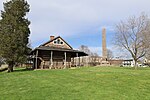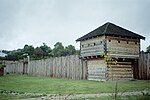Lewis-Capehart-Roseberry House
Federal architecture in West VirginiaHouses completed in 1820Houses in Mason County, West VirginiaHouses on the National Register of Historic Places in West VirginiaMetro Valley Registered Historic Place stubs ... and 2 more
National Register of Historic Places in Mason County, West VirginiaPoint Pleasant, West Virginia

Lewis-Capehart-Roseberry House, also known as "Roseberry," is a historic home located at Point Pleasant, Mason County, West Virginia. It was built about 1820, and is a spacious two story, double-pile, brick residence with a gable roof in the Federal-style. It features sandstone lintels and sills.It was listed on the National Register of Historic Places in 1979.
Excerpt from the Wikipedia article Lewis-Capehart-Roseberry House (License: CC BY-SA 3.0, Authors, Images).Lewis-Capehart-Roseberry House
Roseberry Lane,
Geographical coordinates (GPS) Address Nearby Places Show on map
Geographical coordinates (GPS)
| Latitude | Longitude |
|---|---|
| N 38.876666666667 ° | E -82.134722222222 ° |
Address
Roseberry Lane
Roseberry Lane
25550
West Virginia, United States
Open on Google Maps









